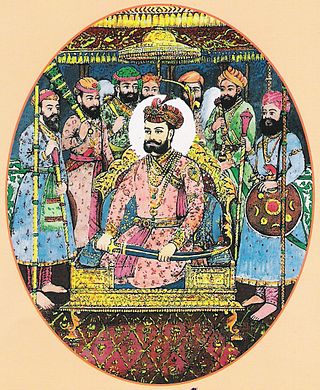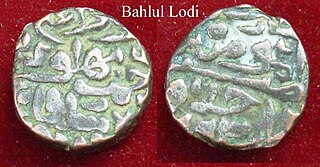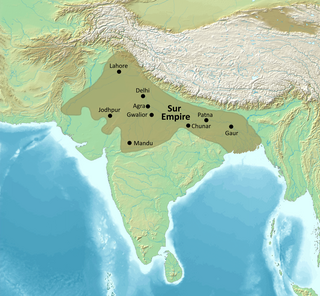Related Research Articles

The Second Battle of Panipat was fought on 5 November 1556, between Akbar and the king of Delhi, Hemu. Hemu had conquered Delhi and Agra a few weeks earlier by defeating Mughal forces under Tardi Beg Khan in the battle of Delhi and crowned himself Raja Vikramaditya at Purana Quila in Delhi.
The Deccan sultanates were five late-medieval Indian kingdoms—on the Deccan Plateau between the Krishna River and the Vindhya Range—that were created from the disintegration of the Bahmani Sultanate and ruled by Muslim dynasties: namely Ahmadnagar, Berar, Bidar, Bijapur, and Golconda. The sultanates had become independent during the break-up of the Bahmani Sultanate. The five sultanates owed their existence to the declaration of independence of Ahmadnagar in 1490, followed by Bijapur and Berar in the same year. Golconda became independent in 1518, and Bidar in 1528.

Mandu or Mandavgad is an ancient city in the present-day Mandav area of the Dhar district. It is located in the Malwa and Nimar region of western Madhya Pradesh, India, at 35 km from Dhar city. In the 11th century, Mandu was the sub division of the Tarangagadh or Taranga kingdom. This fortress town on a rocky outcrop about 100 km (62 mi) from Indore is celebrated for its architecture.

Hemu was an Indian emperor who previously served as a general and Wazir of Adil Shah Suri of Sur Empire during a period in Indian history when Mughals and Afghans were vying for power across North India. He fought Afghan rebels across North India from Punjab to Bengal and Mughal forces of Humayun and Akbar in Agra and Delhi, winning 22 battles for Adil Shah Suri.

Bahlul Khan Lodi was the chief of the Afghan Lodi tribe. Founder of the Lodi dynasty from the Delhi Sultanate upon the abdication of the last claimant from the previous Sayyid rule. Bahlul became sultan of the dynasty on 19 April 1451.

Qutb-ud-Din Bahadur Shah, born Bahadur Khan was a sultan of the Muzaffarid dynasty who reigned over the Gujarat Sultanate, a late medieval kingdom in India from 1526 to 1535 and again from 1536 to 1537. He ascended to the throne after competing with his brothers. He expanded his kingdom and made expeditions to help neighbouring kingdoms. In 1532, Gujarat came under attack of the Mughal Emperor Humayun and fell. Bahadur Shah regained the kingdom in 1536 but he was killed by the Portuguese on board a ship when making a deal with them.

Muhammad Bairam Khan, commonly known as Bairam Khan or Bayram Khan was an important military commander, and later commander-in-chief of the Mughal army, a powerful statesman and regent at the court of the Mughal Emperors, Humayun and Akbar. He was also the guardian, chief mentor, adviser, teacher and the most trusted ally of Akbar. Akbar honoured him as Khan-i-Khanan, which means "King of Kings". Bairam was originally called Bairam "Beg", but later became honoured as Khan. Bairam Khan was an aggressive general who was determined to restore Mughal authority in India.

The Sur Empire was an empire ruled by the Afghan-origin Sur dynasty in northern India for nearly 16 or 18 years, between 1538/1540 and 1556, with Sasaram serving as its capital. It was founded by Sher Shah Suri.

Adham Khan was a general of Akbar. He was the younger son of Maham Anga, and thus, was the foster brother of Akbar. In his fourth regnal year, Akbar married him to Javeda Begum, the daughter of Baqi Khan Baqlani.

Rao Maldeo Rathore was a king of the Rathore dynasty, who ruled the kingdom of Marwar in present day state of Rajasthan. Maldeo ascended the throne in 1531 CE, inheriting a small ancestral principality of Rathore's but after a long period of military actions against his neighbours, Maldeo swept significant territories which included parts of present day Rajasthan, Haryana, Uttar Pradesh, Gujarat and Sindh. He refused to ally with either the Sur Empire or the Mughal Empire.

Muhammad Adil Shah was the fourth ruler of the Suri dynasty, a late medieval Afghan dynasty in the northern Indian subcontinent.

Sikandar Shah Suri was the sixth ruler of the Sur Empire, a late medieval Pashtun dynasty of northern India. He became the sultan of Delhi after overthrowing Ibrahim Shah Suri.

Ibrahim Shah Suri was the fifth ruler of the Sur dynasty, a Pashtun (Afghan) dynasty of late medieval northern India.

Adil Shah Suri was the seventh and final ruler of the Sur Empire. He was the brother in law of Sikandar Shah Suri, who ruled over a region east of Delhi after Sikandar Shah Suri was defeated by Humayun in 1555. He and Sikandar Shah Suri were contenders for the Delhi throne against the Mughal emperor Akbar.

The Malwa Sultanate was a late medieval kingdom in the Malwa region, covering the present day Indian states of Madhya Pradesh and south-eastern Rajasthan from 1401 to 1562. It was founded by Dilawar Khan, who following Timur's invasion and the disintegration of the Delhi Sultanate, in 1401, made Malwa an independent realm.

The Gujarat Sultanate or Sultanate of Guzerat was a late medieval Indian kingdom in Western India, primarily in the present-day state of Gujarat. The kingdom was established in 1394 when Muzaffar Shah I, the Governor of Gujarat, declared independence from the Tughlaq dynasty of Delhi.

The Malwa Subah was one of the original twelve Subahs of the Mughal Empire, including Gondwana, from 1568-1743. Its seat was Ujjain. It shared borders with the autonomous and tributary chiefdoms in the east, as well as Berar, Kandesh, Ahmadnagar (Deccan), Gujarat, Ajmer, Agra, and Allahabad subahs.
The Battle of Chausa was a notable military engagement between the Mughal Emperor, Humayun, and the Afghan warlord, Sher Shah Suri. It was fought on 26 June 1539 at Chausa, 10 miles southwest of Buxar in modern-day Bihar, India. Sher Shah Suri was assisted by his allies, the Ujjainiya Rajputs of Bhojpur and Gautam Rajputs who were led by the commander, Gajpati Ujjainia. Humayun escaped from the battlefield to save his life. Sher Shah was victorious and crowned himself Farīd al-Dīn Shēr Shāh. Babur's cousin, Mirza Haidar asserted that the armies might have numbered over 200,000 troops.
The Battle of Sirhind was fought between the Mughal Empire and the Suri Empire in 1555.
References
- ↑ Begum, Gulbadan (1902). The History of Humāyūn (Humāyūn-nāmah). Royal Asiatic Society. p. 260.
- ↑ Majumdar, R.C. (ed.) (2007). The Mughal Empire, Mumbai: Bharatiya Vidya Bhavan, ISBN 81-7276-407-3, pp.94-6
- ↑ Majumdar, R.C. (ed.) (2007). The Mughal Empire, Mumbai: Bharatiya Vidya Bhavan, ISBN 81-7276-407-3, pp.94-6
- ↑ "Battles for India at Sirhind". Times of India Blog. 2018-03-18. Retrieved 2022-10-25.
- ↑ Sarker, Sunil Kumar (1994). Himu, the Hindu "Hero" of medieval India : against the background of Afghan-Mughal conflicts. New Delhi: Atlantic Publishers and Distributors. ISBN 81-7156-483-6. OCLC 31010168.